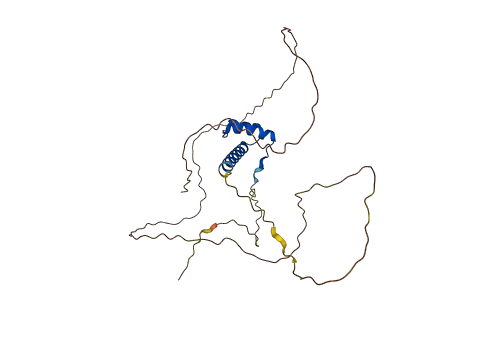Q28FN6
Gene name |
otx2 (TGas114a06.1) |
Protein name |
Homeobox protein OTX2 |
Names |
Orthodenticle 2 |
Species |
Xenopus tropicalis (Western clawed frog) (Silurana tropicalis) |
KEGG Pathway |
xtr:548931 |
EC number |
|
Protein Class |
|

Descriptions
The autoinhibited protein was predicted that may have potential autoinhibitory elements via cis-regPred.
Autoinhibitory domains (AIDs)
Target domain |
|
Relief mechanism |
|
Assay |
cis-regPred |
Accessory elements
No accessory elements
Autoinhibited structure

Activated structure

1 structures for Q28FN6
| Entry ID | Method | Resolution | Chain | Position | Source |
|---|---|---|---|---|---|
| AF-Q28FN6-F1 | Predicted | AlphaFoldDB |
No variants for Q28FN6
| Variant ID(s) | Position | Change | Description | Diseaes Association | Provenance |
|---|---|---|---|---|---|
| No variants for Q28FN6 | |||||
No associated diseases with Q28FN6
1 GO annotations of cellular component
| Name | Definition |
|---|---|
| nucleus | A membrane-bounded organelle of eukaryotic cells in which chromosomes are housed and replicated. In most cells, the nucleus contains all of the cell's chromosomes except the organellar chromosomes, and is the site of RNA synthesis and processing. In some species, or in specialized cell types, RNA metabolism or DNA replication may be absent. |
2 GO annotations of molecular function
| Name | Definition |
|---|---|
| DNA-binding transcription factor activity, RNA polymerase II-specific | A DNA-binding transcription factor activity that modulates the transcription of specific gene sets transcribed by RNA polymerase II. |
| RNA polymerase II cis-regulatory region sequence-specific DNA binding | Binding to a specific upstream regulatory DNA sequence (transcription factor recognition sequence or binding site) located in cis relative to the transcription start site (i.e., on the same strand of DNA) of a gene transcribed by RNA polymerase II. |
6 GO annotations of biological process
| Name | Definition |
|---|---|
| cellular response to alcohol | Any process that results in a change in state or activity of a cell (in terms of movement, secretion, enzyme production, gene expression, etc.) as a result of an alcohol stimulus. |
| cerebellum development | The process whose specific outcome is the progression of the cerebellum over time, from its formation to the mature structure. The cerebellum is the portion of the brain in the back of the head between the cerebrum and the pons. In mice, the cerebellum controls balance for walking and standing, modulates the force and range of movement and is involved in the learning of motor skills. |
| midbrain development | The process whose specific outcome is the progression of the midbrain over time, from its formation to the mature structure. The midbrain is the middle division of the three primary divisions of the developing chordate brain or the corresponding part of the adult brain (in vertebrates, includes a ventral part containing the cerebral peduncles and a dorsal tectum containing the corpora quadrigemina and that surrounds the aqueduct of Sylvius connecting the third and fourth ventricles). |
| midbrain-hindbrain boundary development | The process whose specific outcome is the progression of the midbrain-hindbrain boundary over time, from its formation to the mature structure. The midbrain-hindbrain domain of the embryonic brain is comprised of the mesencephalic vesicle and the first rhombencephalic vesicle at early somitogenesis stages. |
| regulation of transcription by RNA polymerase II | Any process that modulates the frequency, rate or extent of transcription mediated by RNA polymerase II. |
| retinal pigment epithelium development | The progression of the retinal pigment epithelium over time, from its initial formation to the mature structure. The retinal pigment epithelium is the melanin-containing layer of cells between the retina and the choroid that absorbs scattered and reflected light and removes waste products produced by the photoreceptor cells. |
10 homologous proteins in AiPD
| UniProt AC | Gene Name | Protein Name | Species | Evidence Code |
|---|---|---|---|---|
| Q9XSK0 | CRX | Cone-rod homeobox protein | Bos taurus (Bovine) | PR |
| O43186 | CRX | Cone-rod homeobox protein | Homo sapiens (Human) | PR |
| P32243 | OTX2 | Homeobox protein OTX2 | Homo sapiens (Human) | PR |
| O54751 | Crx | Cone-rod homeobox protein | Mus musculus (Mouse) | PR |
| P80206 | Otx2 | Homeobox protein OTX2 | Mus musculus (Mouse) | PR |
| Q6H6S3 | HOX24 | Homeobox-leucine zipper protein HOX24 | Oryza sativa subsp japonica (Rice) | PR |
| Q7XUJ5 | HOX22 | Homeobox-leucine zipper protein HOX22 | Oryza sativa subsp japonica (Rice) | PR |
| A3BYC1 | HOX25 | Homeobox-leucine zipper protein HOX25 | Oryza sativa subsp japonica (Rice) | PR |
| Q9M276 | ATHB-12 | Homeobox-leucine zipper protein ATHB-12 | Arabidopsis thaliana (Mouse-ear cress) | PR |
| Q91994 | otx1b | Homeobox protein OTX1 B | Danio rerio (Zebrafish) (Brachydanio rerio) | PR |
| 10 | 20 | 30 | 40 | 50 | 60 |
| MMSYLKQPPY | AVNGLSLTTS | GMDLLHPSVG | YPATPRKQRR | ERTTFTRAQL | DVLEALFAKT |
| 70 | 80 | 90 | 100 | 110 | 120 |
| RYPDIFMREE | VALKINLPES | RVQVWFKNRR | AKCRQQQQQQ | QNGGQNKVRP | SKKKPSPARE |
| 130 | 140 | 150 | 160 | 170 | 180 |
| VSSESGTSGQ | FSPPCSTSVP | VISSSTAPVS | IWSPASISPL | SDPLSTSSSC | MQRSYPMTYT |
| 190 | 200 | 210 | 220 | 230 | 240 |
| QASGYSQGYA | GSTSYFGGMD | CGSYLTPMHH | QLSGAGATLS | PMGTNAVTSH | LNQSPAALSS |
| 250 | 260 | 270 | 280 | ||
| QAYGASSLGF | NSTADCLDYK | DQTASWKLNF | NADCLDYKDQ | TSSWKFQVL |